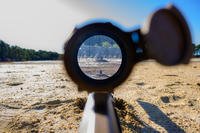From hand-release push-ups to the max deadlift and sprint-drag-carry, the grueling new Army Combat Fitness Test provides participants with lots of reminders of how hard it is to resist the pull of gravity.
But what would the ACFT be like if conducted in outer space? Wonder no longer.
In a video released this week by the Army's Medical Center of Excellence, Army Col. Drew Morgan, a NASA astronaut, demonstrates the test while aboard the International Space Station. Some events still presented a physical challenge, thanks to special equipment that enables astronauts to work out in "zero-gravity" conditions; others simply seemed ridiculous.
Read Next: Air Guard Can't Confirm That Columbus Police Officer Had Marksmanship Badge
Morgan, who was selected by NASA to become an astronaut in 2013, is an Army emergency physician and former member of the U.S. Military Academy's "Black Knights" parachute demonstration team. He was last at the International Space Station from July 20, 2019, to April 17, 2020. The video release comes the same week two other NASA astronauts, Shane Kimbrough and Megan McArthur, departed on the SpaceX Falcon 9 rocket for a tour aboard the ISS, joining an international crew already in orbit.
While gravity does exist aboard the ISS, the orbit of the space station creates conditions of perpetual free fall, leading to the sensation of weightlessness. Everything from eating to using the restroom becomes more complicated in these conditions. And, as Morgan demonstrates, working out presents its own special challenges.
For the first ACFT event, the three-repetition max deadlift, Morgan gets strapped into an exercise machine that keeps him stationary and allows him to pull a resistance bar -- all while in a horizontal, supine position. And that, it appears, is the easy part.
Next is a two-mile run on the treadmill, also done with special aids. Morgan wears a chest strap and waist belt to keep his feet in contact with the moving belt.
After that, things get a little funky. The hand-release push-up, which requires performers to start with their chest on the ground, push their arms to full extension, come back to the ground and lift their hands for a single rep, is intended to be a more rigorous test of upper-body strength than a conventional push-up. While Morgan manages to perform a few conventional push-up reps thanks to a fixed bar on the floor of the space station, he begins to float away when he releases his hands.
"I can keep doing a push-up without my hands," he says with a grin.
The leg tuck, another test of upper-body strength that involves hanging from a bar, flexing the arms and bringing the knees up to touch the elbows for a single rep, looks significantly easier when done at the ISS. Morgan hangs onto a bar upside-down. After bringing up his knees, he releases his grip on the bar and the momentum sends him spinning in place.
The final event Morgan demonstrates is the standing power throw. Meant to be conducted with a 10-pound medicine ball forcefully thrown backward overhead, the event measures explosive strength. It also seems potentially dangerous inside the ISS. Morgan takes a much smaller ball and carefully launches it behind him. It travels backward without seeming to stop.
The Army astronaut doesn't bother attempting the sprint-drag-carry, which requires a weight sled and a 25-meter running lane, neither of which are available on the ISS.
"Take care; Go Army," Morgan says as he signs off.
By April 1, 2022, all soldiers will need to get passing scores on the ACFT, the first Army fitness test designed to be age- and gender-neutral. Challenges in transitioning to the new test -- such as the difficulty many soldiers have in passing the leg tuck -- have prompted Army leaders to make a series of revisions and modifications, such as adding a two-minute plank event.
Perhaps they should just give soldiers the option of taking the test in space.
-- Hope Hodge Seck can be reached at hope.seck@military.com. Follow her on Twitter at @HopeSeck.
Related: At 53, I Took the Tough New Army Combat Fitness Test. Here's How It Turned Out














